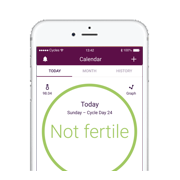High-tech fertility apps: What’s the deal with Natural Cycles?
We're taking a closer look at Natural Cycles digital birth control.

What are fertility awareness-based methods?
Fertility awareness-based methods (sometimes also called “natural family planning” methods) are one inexpensive way for people to prevent pregnancy without taking hormones. They’re all about tracking your menstrual cycle and other signs of fertility to determine the days that you can get pregnant and then not having sex on those days or using a form of protection like condoms on those days.
In recent years, a bunch of different fertility awareness apps have hit the market for people who want to track their cycles on smartphones. The popularity of these apps reached a new high in 2017 when Natural Cycles became the world’s first app to gain government approval from the European Union as an actual birth control method. The app has now been approved by the FDA for marketing as a form of contraception. Natural Cycles is the first mobile app to get this approval.
How does Natural Cycles work?
The app relies on a form of pregnancy prevention known as the basal body temperature method, or BBT method. Your basal body temperature is your temperature when you’re fully at rest. This method relies on the fact that most women’s body temperature increases slightly (like half a degree) during ovulation. We recommend that anyone using the BBT method combine it with another fertility awareness method or with another form of birth control.
To use the BBT method, you take your temperature using a special thermometer that you stick underneath your tongue every morning before you move around at all, while you’re still in bed. You track these daily temperatures in a chart and when you see them increase, you assume you’re ovulating.
With Natural Cycles, you enter your daily basal body temperature and info about your period into the app. The app then uses an algorithm that looks at small changes in your temperature to predict your fertility day by day and tells you whether or not you are likely to get pregnant that day from having unprotected sex.
According to Natural Cycles CTO and Founder Elina Berglund, “The more data you enter, the better Natural Cycles is at narrowing in on your fertile days. Natural Cycles looks at information that has been input across cycles, so its algorithm takes into account much more data than a woman would who was using the BBT method looking at cycles one month at a time.”
How well does Natural Cycles work?
Natural Cycles claims that it is 93% effective with typical use (typical use means the way most people use it, which is not perfectly). The Swedish app came under fire after a number of women reported unplanned pregnancies, but an investigation by the Swedish Medical Products Agency (Läkemedelsverket) concluded that the numbers were in line with the 93% effectiveness rate.
Really, no method is 100% effective, so it’s a given that some users will experience unplanned pregnancies. Just like with any method, the better you are at using it, the better it will work. In the case of Natural Cycles, this means entering all of your data accurately, measuring your temperature correctly and consistently, and using back-up protection or not having sex on days the app says you are fertile.
But even if you use this app perfectly, there could be problems. First of all, the BBT method can be thrown off by other causes of change in temperature besides ovulation, like being sick, hungover, or taking certain medications. Also, BBT can tell you when you are likely to have ovulated, but it can’t predict when you will ovulate. This is a problem because sperm can live inside your body for up to 5 days. So, for example, if you have unprotected sex on a day that the app tells you you’re not fertile, but then you ovulate the next day, that sperm could still be hanging around inside of you and get you pregnant.
So, what does this mean when it comes to fertility awareness methods?
Apps may seem like a great option for those looking for low-cost, non-hormonal birth control, but they’re definitely only an option for you if you’re okay with using a back-up birth control method (like condoms) or not having sex when you’re in your predicted fertile window (which might be up to around half of every month depending on how regular your cycle is.)
Even if you track your cycle really well, compared to some other types of contraceptives, such as the IUD, fertility awareness methods are not as effective and require a lot more effort to use. Using more than one fertility awareness method at a time may increase effectiveness, but requires even more effort.
How do you feel about this article?

Heat up your weekends with our best sex tips and so much more.
